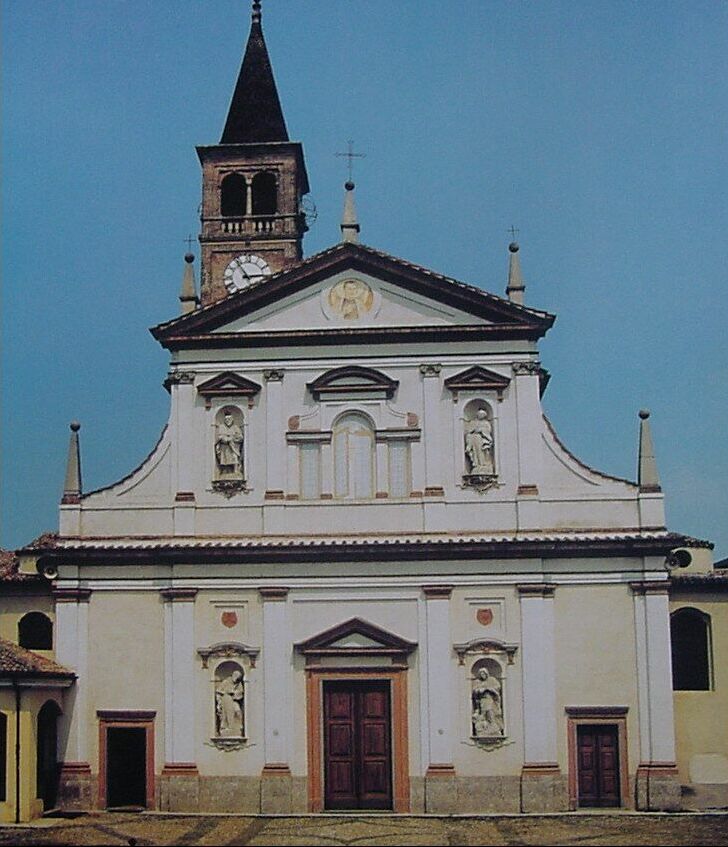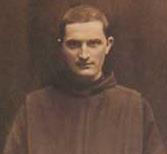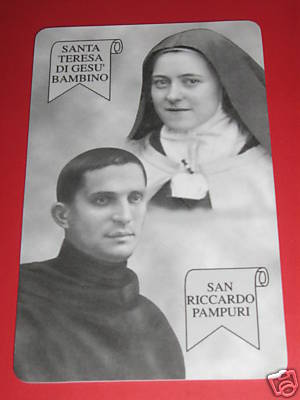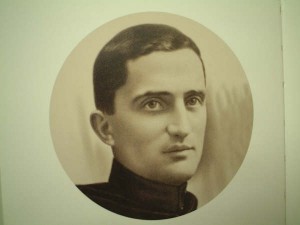SAINT RICHARD PAMPURI O.H.
Posted on Febbraio 22nd, 2009 di Angelo |
RICHARD PAMPURI O.H.
(1897-1930)
ERMINIO FILIPPO PAMPURI, Brother Richard in religion, was the tenth of the eleven children of Innocenzo and Angela (nee Campari) Pampuri. He was born at Trivolzio (Pavia, Italy), on 12 August 1897 and was baptised the following day.
When he was three years of age his mother died and he was then taken into the home of his mother’s sister, at Torrino, a village near Trivolzio. In 1907 also his father is expired at Milan.
He went to two primary schools at nearby villages and then went to Milan where he attended a junior high school. He completed his high school studies as a boarder at Augustine’s College, Pavia, where after graduation, he enrolled in the Medical Faculty of Pavia University.
Between the years 1915 and 1920, he was in the fighting zone of World War I. He served firstly as a sergeant and later went into training as an officer in the Medical Corps.
On 6 July 1921, he graduated top of his class in Medicine and Surgery at the above mentioned university.
After a three years practical experience with this doctor uncle, and for a short time as temporary assistant in the medical practice at Vernate, he was appointed to the practice of Morimondo (Milan). In 1922 he passed his internship with high honours at the Milan Institute of Obstetrics and Gynaecology. In 1923 he was registered at Pavia University as a General Practitioner of Medicine and Surgery.
Very soon his heart and mind began opening up to the Christian ideals of medicine and the apostolate. Even as a young boy he wanted to become a missionary priest, but was dissuaded from this on account of his delicate health.
From his youth he was always a shining example of Christian virtue everywhere he went. Whilst living in the midst of the world, he openly and consistently professed the Gospel message and practised works of charity with generosity and devotion. He loved prayer and kept himself constantly in close union with God, even when he was kept very busy.
Saint Richard
Saint Richard,
you once walked the roads of our land,
you prayed in the silence of our churches,
you lovingly and intelligently served the sick in our homes,
you have been welcoming towards each person that looked for you.
Today, as once your patients did,
I too look for you and turn to you,
so that you help the healing of my body and spirit,
and so that you grant for me, from the Lord,

Prayer to Saint Riccardo for young people
Saint Riccardo, we have come to your tomb
That you may help us onto your path.
Like us, you dreamed, Riccardo,
Pray to God
That our hopes may be fulfilled.
Like us, you studied, Riccardo,
Pray to God
That His truth may be made known to us.
Like us, you went through troubles, Riccardo,
Pray to God
That he may make us stronger in life.
Like us, you waited, Riccardo,
To understand the directions your future was to take.
Pray to God
That we may always be watchful
And able to recognize the path to which He calls us.
Like Jesus, you managed to hope, even through difficulties,
And pray amidst thousands of worries,
And love under all circumstances,
Ask the Lord to grant us
The enthusiasm and generosity with which you lived.
Amen.
Riccardo Pampuri’s memorial tablet
List of Countries » Italy » Pavia » Medical monuments and memories in the University central seat » Riccardo Pampuri’s memorial tablet
One of the Medical monuments and memories in the University central seat, in Pavia, is the marble memorial tablet to the memory of Saint Riccardo Pampuri who studied medicine in this University from 1915 to 1921. He graduated on the 6th July 1921, with a doctoral thesis on the “Determination of the arterial pressure with a new sphygmomanometer”.
PAVIA – UNIVERSITY
The italian inscription on the tablet reads as follows:
“BENIGNO QUI ANCORA SPIRI L’AMORE
DI CUI SI INFIAMMO’ IN MODO ERICO
ERMINIO PAMPURI
ALUNNO ESEMPLARE E MITISSIMO
DI QUESTA UNIVERSITA’
ORA ELEVATO AGLI ONORI DEGLI ALTARI
E INVOCATO CON IL NOME DI
S.RICCARDO
DELL’ORDINE OSPEDALIERO
FATEBENEFRATELLI
QUANTI NE SEGUONO LE ORME
SENTANO COSTANTE LA SUA PROTEZIONE
 |
TRIVOLZIO / 2.8.1897 / MILANO / 1.5.1930″.
He assiduously attended the Eucharistic table and spent long periods in profound adoration before the Tabernacle.
He had a tremendous devotion to the Blessed Virgin Mary and prayed the Rosary often more than once a day.
He was an active and diligent member of Pavia University’s Severino Boezio Club for Catholic Action. He also belonged to the St. Vincent de Paul Society and the Third Orden of St. Francis.
Since his boyhood he was involved in Catholic Action so when he arrived at Morimondo to practice medicine, he gave valuable assistance to the parish priest and helped him to set up a musical band and a Catholic Action Youth Club of which he was the first president. Both of these under the patronage of St. Pius X. He was also secretary of the Parish Missionary Aid Society.
He organised regular retreats for the Youth Club, farm labourers and local workers, at the Jesuit Fathers’ “Villa del Sacro Cuore” at Triuggio, generally paying their expenses. He used to invite his colleagues and friends to come along as well.
As well as being studious and competent in practising his profession, he was generous, charitable and very concerned for his patients. Throughout his practice he visited them both by day and night, never sparing himself no matter wherever they lived, even in places difficult to find. Since most of his patients were poor, he gave them medicines, money, food, clothing, and blankets. His charity extended to the poor rural workers and needy folk in and around Morimondo and even going further afield to other towns and districts.
When eventually he was to leave his practice in six years time, to become a religious, the grief at having lost the “holy doctor” was so greatly felt everywhere, that even the daily press took up the story.
Dr. Pampuri joined the Hospitaller Order of St. John of God so as to follow the way of evangelical holiness more closely and at the same time to be able to carry on his medical profession so as to alleviate the suffering of his neighbour. He joined the St. John of God Brothers at Milan on 22 June 1927. He did his novitiate year at Brescia and when it was over, made his profession of religious vows on 24 October 1928.
He was then appointed Director of the dental clinic attached to the St. John of God Brothers’ Hospital at Brescia. This was mostly frequented by working people and the poor. Brother Richard untiringly gave himself fully to serving them with such wonderful charity that he was admired by all.
Throughout his life as a religious, Brother Richard was, as he had always been before he became a St. John of God Brother, a model of virtue and charity: to his Brothers in the Order, the patients, the doctors, the paramedics, the nurses, and all who came into contact with him. Everybody agreed upon his sanctity.
He suffered a fresh outbreak of pleurisy, which he first contracted during his military service, and this degenerated into specific bronco-pneumonia. On 18 April 1930 he was taken from Brescia to Milan, where he died in sanctity on 1 May at the age of 33 years: “leaving behind, the memory of a doctor who knew how to transform his own profession into a mission of charity; and a religious brother who reproduced within himself, the charism of a true son of St. John of God” (Decree of heroic virtue, 12 June 1978).
After his death, his reputation of sanctity which he demonstrated throughout his life, greatly expanded throughout Italy, Europe and the entire world. Many of the faithful received significant graces from God, even miraculous ones, through his intercession.
The two required miracles were accepted and he was beatified by His Holiness John Paul II on 4 October 1981.

Erminio Filippo Pampuri
Riccardo Pampuri
Ricardo Pampuri
Memorial
1 May
Profile
Tenth of the eleven children born to Innocenzo and Angela Pampuri. His mother died of tuberculosis when Erminio was three, and he was raised by his maternal grandparents and an aunt. His father died in a traffic accident when Erminio was ten.
Though he wanted to become a missionary priest, one of the great influences on the boy was his uncle Carlo, a village doctor. When Erminio’s health proved to be too weak for the rigors of missionary work, he studied medicine at Pavia University. Franciscan tertiary, member of the Society of Saint Vincent de Paul, and involved in Catholic Action, he attended Mass daily while in school.
Drafted into the Italian army medical corps in World War I in 1917, Erminio was a sergeant; he spent his duty in field hospitals, sickened by the misery of war.
He resumed his studies in 1920, and graduated from medical school on 6 July 1921 at the top of his class. Rural health officer in Morimondo in the Po Vally, a poor area near Milan, Italy. Secretary for his parish’s missionary society, he organized retreats for local laymen, and worked area youth. He treated the poor for free, coordinated charitable drives for them, and founded the Band of Pius X, a group dedicated to medical care for the poor.
Feeling a call to religious life, Erminio joined the Hospitaller Order of Saint John of God on 22 June 1927, taking the name Riccardo, and making his formal profession on 24 October 1928. Ran a free dental clinic for the Order in Brescia, treating those in need, and giving them money and food in the bargain if they needed it.
Born
2 August 1897 at Trivolzio, Pavia, Italy as Erminio Filippo Pampuri
Died 1 May 1930 in Milan, Italy of pleurisy, tuberculosis and pneumonia
All information used with permission of the Patron Saint Index.
Later on, a miraculous healing through the intercession of Blessed Richard Pampuri, took place on 5 January 1982 at Alcadozo (Albacete, Spain). This was approved as a miracle and so, on the feast of All Saints, 1 November 1989, he was solemnly canonized.
“The brief, but intense life, of Brother Richard Pampuri is a stimulus for the entire People of God, but especially so for youth, doctors and religious brothers and sisters.
He invites the youth of today, to live joyfully and courageously in the Christian faith; to always listen to the Word of God, generously follow the teachings of Christ’s message and give themselves to the service of others.
He appeals to his colleagues, the doctors, to responsibly carry out their delicate art of healing; vivifying it with Christian, human and professional ideals, because theirs is a real mission of service to others, of fraternal charity and a real promotion of human life.
Brother Richard recommends to religious brothers and sisters, especially those who quietly and humbly go about their consecrated work in hospital wards and other centres, to hold fast to the original charism of their Institute in their lives, loving both God and their neighbour who is in need” (Homily, 4 October 1981).
St. Richard Pampuri’s body is conserved and venerated in the Parish Church of Trivolzio (Pavia, Italy). His feastday is celebrated on 1 May.
By Tony Staley
Compass Editor
|
|
|
|
|
|
St. Richard PampuriWhen: 1897-1930Where: Northern ItalyWhat: Physician and religious brotherFeast: May 1 |
|
|
|
Thirty-three years is a short time in which to make a mark, though that’s all it took Jesus — and St. Richard Pampuri, who in 1989 was canonized for his life of virtue as a doctor, friend of the poor and religious brother.
Richard, who was baptized Erminio, was three when his mother, Angela, died of tuberculosis and 10 when his father, Innocenzo, was killed in a car accident. The two deaths left his upbringing to his maternal grandparents and an aunt and uncle.
Erminio had long wanted to be a missionary priest, but ill health made that impossible. So he decided to follow the example of his Uncle Carlo, a village doctor.
His uncle paid for his education at Pavia University, where Richard attended daily Mass, became a lay Franciscan, and was active in the Society of St. Vincent de Paul and Catholic Action.
World War I interrupted his studies in 1917 when he was drafted into the Italian army medical corps, given minimal training and sent to a field hospital.
The brutality of war dismayed Erminio. He wrote: “What a stupid waste of human life. So many wounded, so many broken bodies!”
He soon earned respect for his care for patients. One colleague put it, “He was always very kind to the wounded soldiers, particularly those with the gravest wounds. He was always on hand to comfort them and was concerned that they should receive the Sacraments.”
Whenever Erminio had time, he read the New Testament and the Imitation of Christ, which he always carried with him.
In 1920, he resumed his studies, graduating at the top of his class the next year, after completing course work in medicine, surgery, obstetrics and gynecology.
At first, he practiced at a rural health clinic near Milan. He worked mainly among the poor, to whom he also gave money, food, clothing and blankets. He also was the secretary for the parish missionary society, and organized retreats for the laity and worked with youth.
Erminio, who saw his work as ministry, wrote to his sister, a missionary in Egypt: “I always see Jesus in my patients, so it is he whom I cure, comforting him who suffered and died to expiate our sins.”
On June 22, 1927, at the advice of his spiritual director, he entered the Hospitaller Order of St. John of God, taking the name Richard. His superior put him in charge of the order’s free dental clinic. He proved popular among patients, to whom he gave money and food, in addition to dental care.
But in August 1929, he came down with a lung disease — a legacy of the war — and died less than a year later.
(Sources: Brothers of St. John of God, Butler’s Lives of the Saints, catholic-forum.com, Catholic News Service, Saints Alive.)
This icon CHRIST–THE DIVINE PHYSICIAN
of Christ which is displayed in the sidebar of our website was painted by a medical colleague, a member of the Catholic Medical Association. The artist/physician wrote about the work:
“The inspiration for this icon came from the ancient icon at St Catherine’s monastery in Sinai – Christ the Pantocrator (Christ the Ruler, King). The ancient icon dates back to the year 500 AD and has lost its color so that it appears black and white and gold yet it is still very profound. Christ is holding His right hand to bless the viewer and His left hand holds the Word of God.
I ‘wrote’ (painted) this icon using the Sinai icon as a model. Christ wears a tunic of red to symbolize His suffering and death for our redemption. His robe of purple represents Kingship and royalty. The gold (real gold) of His halo, shoulder badge and book indicate divinity. The letters on His halo are the letters for the name of God “I AM”.
This is my prayer and contemplation: Christ the Divine Physician is the rightful Lord (Ruler, King) of medicine and of physicians. He calls us to be physicians in His image. Our response to His call is to profess an oath (~Hippocratic Oath) to Him of obedience and obligation and responsibility to Him for the care of His people in the practice of medicine. I pray that all who contemplate this icon of Christ the Divine Physician will become more and more conformed to His image as Healer.”
http://www.worcestercma.org/ChristDivinePhys.html
SAINT RICHARD PAMPURI
b. August 12, 1897, Trivolzio, Italy
d. May 1, 1930, Milan
Beatified: October 4, 1981
Canonized: November 2, 1989
The Old Testament Book of Sirach pays an important tribute to physicians. “Hold the physician in honor,” Sirach says, “for he is essential to you, and God it was who established his profession” (38:1). St. Paul calls St. Luke the Evangelist a “beloved physician” (Col, 4:14). In our own time another saintly medical doctor has been canonized to whom God has communicated some of his healing power. He is St. Richard Pampuri, M.D.
Dr. Pampuri, the tenth of the eleven children of Innocenzo and Angela Pampuri, was born in the province of Pavia, northern Italy, on August 2, 1897, and baptized Erminio Filippo. His mother, in poor health, died when he was only three. Thereupon, his maternal grandparents offered to raise the youngster in their village. The grieving father accepted their kindly offer.
Growing up in the household of his grandfolks his Aunt Maria and her husband Dr. Carlo, the village physician, Erminio had the great blessing of being raised in an atmosphere of devout and loving Christianity. From the outset, he proved to be a winsome child naturally disposed to do the right thing. Though not physically strong, nevertheless, when he started to go to school, he did not allow the long walks to and from the schoolhouse, in weather fair or foul, to interfere with his perfect attendance. His teachers in elementary and secondary school all spoke of him as “outstanding under every aspect”.
When Erminio was ten, his father was killed in a traffic accident. Even as a lad young Pampuri had wanted to become a missionary priest, but he was dissuaded from that vocation because of his delicate health. Instead, he fell more and more under the influence of his uncle Carlo, a country doctor whose generosity and good example impressed him with the ministry of healing. Carlo also paid his way through schools and college. He must have been gratified when Erminio told him that he had enrolled in the Faculty of Medicine at Pavia.
The impression he made on teachers and fellow students while in college and medical school continued to be very positive. His quiet excellence in behavior and study made him a natural leader. Despite the anticlerical milieu of the university, he calmly attended daily Mass and received Holy Communion regularly. He was active in the student Catholic Actions groups, and attracted large numbers of his fellow students to these apostolates.
When Italy entered World War I, Erminio Filippo was conscripted into the Medical Corps. After a brief course in field medicine he was sent to the front. Most of his work seems to have been in field hospitals, but he was nevertheless shocked by the brutality of war. “What a stupid waste of human life,” he wrote. “So many wounded, so many broken bodies!” He outdid himself in serving these casualties. A companion said of him, “He was always very kind to the wounded soldiers, particularly those with the gravest wounds. He was always on hand to comfort them and was concerned that they should receive the Sacraments.” Personally he always carried the New Testament and the Imitation of Christ in his pocket, to be read in the brief moments of leisure. By the end of the war he had been promoted to Second Lieutenant, Medical Corps.
When the war ended in 1918, Erminio returned to the Medical School of Favia. On July 6,1921, he graduated at the top of his class in medicine and surgery. In 1922 he completed his internship with high honors, and was appointed to practice at Morimondo in the Province of Milan. Now he practiced medicine to the hilt. But he also found time to organize the parish youth, to serve as secretary of the parochial missionary society, and arrange retreats for adolescents, farmers and Don Alesina, pastor of the parish, called him “my lay curate”.
Now that he was a physician, Pampuri was able to prove to himself that his profession was indeed a “ministry”. “I always see Jesus in my patients,” he wrote to his sister, a missionary in Egypt, “so it is He whom I cure, comforting Him who suffered and died to expiate our sins.” Since most of his patients were poor, he gave them free medicine and money, food, clothing and blankets as needed.
Dr. Pampuri still felt an attraction to the religious life. After six years at Morimondo, on the advice of his spiritual director, he decided to join the Hospitallers of St. John of God, a religious order of nursing brothers. The Brothers were happy to receive him. He entered the Order officially in 1927, received the religious name “Riccardo” (Richard) and took his first vows in 1928. His new companions quickly agreed that Brother Richard was in every way an authentic son of St. John of God.
Unfortunately, Pampuri, while in the armed services, had suffered a bout with pleurisy. That ailment struck him anew in August 1929, and degenerated into bronchial pneumonia. He died in the Order’s hospital in Milan on May 1, 1930, aged only 33.
The speed with which he was beatified and canonized testifies to the reputation for high holiness that this admirable young man had acquired. Pope John Paul II declared him blessed in 1981 and proclaimed him a saint in 1989.
In a day when many physicians seem to ignore their Hippocratic oath to do patients no harm, it is good to have ranked among the saints one who saw Jesus in those whom he sought to cure.
–Father Robert F. McNamara
(source: http://www.irondequoitcatholic.org/index.php/St/RichardPampuri/)
http://www.worcestercma.org/Pampuri.html
Filed under: St. Richard Pampuri (english), THE WORCESTER GUILD OF THE CATHOLIC MEDICAL ASSOCIATION









